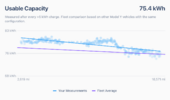Its actually the other way around.
The urban legends is like:
”Charging to 80 (or 90%) is the best for longevity because Tesla says that”
—> IRL Tesla say ”less than 90%
”If you charge to 100% you need to drive asap, otherwise the battery get hurt”
—> IRL there is no data suggesting 100% is much worse than 80-90%. In extreme temperatures the rate is higher but not by far. (This doesnt mean I recommend leaving it there for long periods)
“Going below 20% is bad for the battery.”
—> IRL there is no data that support this myth. Actually, the lower the better down to 0%.
We do see differences.
First, I started to use the low SOC strategy more or less directly after delivery. I have about 18-20% Supercharging energy wise (~50 sessions) and about 30 charges to 100%.
2 yrs 4 months (61K km) and the difference is clear.
There is quite a few cars here and at a swedish forum that adopted the low SOC stategy, the low range drop is seen by virtually all of the one I know of.
View attachment 932605
I started to learn about lithium batteries about 2006-2007, because tgere was myths already then. After reading research I adopted the low SOC during storage.
I still have lithium polymer batteries from 2009 that works fine today but most of my friends have to throw their batteries after a few years.
The science /research is agreeing very much on how lithium ion batteries work and what cause them to degrade.
There really is not much to be uncertain about if lokking into the sum of all research results.
Tesla off course want to give the owner as few restrictions as possible. It should be easy to own and use an EV.
If Tesla on one hand said EPA range = 358 miles, and on the other hand said “please do mot charge more than 55%, they probably would be sued for non true advertisement.
Teslas advise will not be the ones maximizing battery longevity. They will ensure that the batteries in general will not need warranty replacements (100.000 miles and eight years is the law mininum warranty in US).
Its quite safe to say that you can reduce the degradation to half (or better) by staying low in SOC (as much time as possible below 55%).
If you tell me:
-What tesla you have (for knowing original capacity and range).
- how old it is, down to months ( X yrs Y months) since delivery or build date.
- To what SOC you charged most times.
-End of day SOC (before next charge)
- when /time on the day you start the charge
- The climate where you live, average temp.
- if you park it in a garage or outside.
Then I’ll tell you your expected degradation, expected range today.
(This assumes you owned it since new or know this data for the previous owner as well).
You do not even need to tell me the miles driven.
Tested on quite a few cars so far and it mostly hit quite close.
(This is because calendar aging is predictable and also the main degrading factor for the first 5-8 years.)
Try me!




